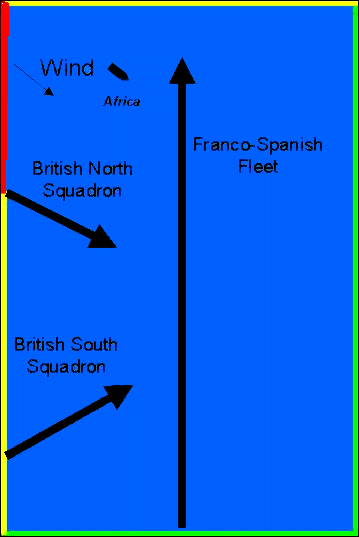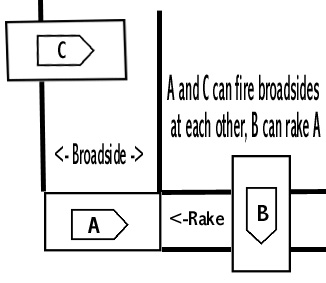The Miniatures:
I used 2-D paper ships for this battle. I made the paper ships from some free clip art I found on http://Download-Free-Pictures.com/ .
Six ships should fit on a standard page, just cut and paste them onto a page and print as many as you need. I printed mine on some heavy paper so they would be sturdier. If you don't have a good color printer try the black and white version. It can be reproduced on a photocopier and then colored by hand (a good job for the kids). If you have limited table space then their size can be reduced.
If you want to identify the ships by name it would be a good idea to do this on the computer. I didn't think of this until after the ships had been printed, so I made the names on put the names on address labels and pasted them on afterwards. You'll want to identify the flagships. I did this with a gold star after their name.
After cutting apart the ships on each page I used a sharp knife to score the line between the two halves before folding and gluing with Elmer's. I pressed the ships under a heavy weight while drying so they would be nice and flat. After the glue dried I cut out the ship's outline. Leave a little white space around the ship just in case the two halves aren't perfectly aligned. I cut some illustration board into 2" x 1" rectangles to serve as bases. These were painted blue to match the table cloth.
I attached the ships using a clever method using two pieces of transparency stapled onto the bases. This technique is described by Patrick Crusiau on his Cardboard Fighters website (http://users.skynet.be/gwindel/index.html).
I found that the ships often came off the bases when the kids picked them up (I think I bent the transparency too much) so I glued them down with Elmer's glue.
You'll need a way to mark the hits on the ships. The method I used was to draw circles on the bases (six for flagships, five for regular ships) and assign a couple of reliable students to mark the hits with dry erase markers. You might also try using double sided tape to attach some kind of markers, or having the kids keep a written record for their own ships.
|
British Fleet (27 ships) British North Squadron (12 ships) Victory (Nelson), Brittania British Southern Squadron (15 ships) Royal Sovereign |
Franco-Spanish Fleet (33 ships) French Fleet (18 ships) Bucentaure, Formidable (Villeneuve),
Algeciras Spanish Fleet (15 ships) Santissima-Trinidad, Principe de
Asturias, Santa Anna |
 The Board:
The Board:
I covered a 7.5' x 5' table with a blue table cloth and used colored yarn taped around the edges to indicate the wind direction. Green yarn marked the East and West table edges (wind at your back, full speed). Yellow yarn bordered the North edge, and 2/3 of the West edge (close quartered, half speed). Red yarn ran 2.5' south from the northwest corner (can't move directly into the wind).
Deployment :
The French and Spanish ships are deployed in an untidy line a bit west of the middle of the table starting about 6" from the northern edge extending all the way to the south edge. The ships should be 2" - 4" apart. The British are in two squadrons headed perpendicular to the Franco-Spanish line. The North Squadron should be led by the Victory and Brittania, the South Squadron is led by the Royal Sovereign. The British squadrons don't need to be in a single file column, spread them out a bit. The Africa was off by itself near the head of the Franco-Spanish fleet.
When I ran this battle the second time I had a smaller group of students. I removed 1/2 of the ships from each side and every student was still able to command two ships. The battle ran smoother and easier with the smaller number of ships.
Sequence of Play:
1. Drift
2. Franco-Spanish Move
3. British Move
4. British Shoot
5. Franco-Spanish Shoot
6. Boarding Actions
Drift:
Any ships that are fouled or grappled may attempt to get lose. The commander wishing to get loose rolls a die. The ships remain fouled or grappled if the rolls 1-4, they will only drift this turn. If the roll is a 5-6 the ships are freed and may move normally this turn. Both captains may roll (but not drifting wrecks), and if either is successful the ships are free. Any ships that remain fouled or grappled and any ships that surrendered on a previous turn now drift downwind 3" (SE). If a drifting ship's base hits another ship roll it may become fouled or grappled, see that section of the rules for the procedure.
Movement:
The speed of movement depends on what direction the ship is pointing at the start of the turn. If the ship is pointing towards the green then the wind is behind the ship and it may move up to 6" and make one turn up to 90 degrees. If the ship is pointing towards the yellow it is close quartered and may move up to 3" and make one turn up to 90 degrees. If a ship is pointing towards the red then it is "locked in irons." If pass a skill check to move. French and Spanish ships need to roll a 5-6, British need to roll a 4-6. If the roll is successful the ship may move up to 3" and make one turn up to 90 degrees. If the roll fails the ship does not move. Note: ships may not turn through the red during their move. If they turn towards the red during their move the ship must end its move pointed in that direction and attempt a "locked in irons" roll next turn.
 Shooting:
Shooting:
Ships may only fire to the broadside. This is defined as the area to the sides of the ship as defined by the base (see diagram). Ships may only fire at a ship if part of its base is in this area. British ships roll seven dice when firing, French and Spanish ships roll five dice. Flagships get to roll one extra die.
The firing ship rolls its dice to determine hits. Long range is 6"-12" and 6's are required for hits. Short range is 0" - 6" and a 5-6 is a hit. A rake is defined as fire at short range from a ship whose base is mostly in the front or rear of a ship as defined by the target ship's base (see diagram). Raking fire hits on a 4-6. Flagships can take 6 hits, other ships can take five hits. When a ship loses its last hit point it surrenders (strikes its colors). This can be marked by putting some cotton on it.
A ship which has surrendered can no longer move or fire. It is not removed from the board, however, since it will drift and can become an obstacle. Note: each ship may only fire once per turn, and ships may not fire through or "over" other ships, or fire fire through narrow gaps between ships.
Fouling & Grappling:
If at the end of the any drift or movement phase the bases of two ships are in contact there is a chance they will become entangled. If one of the ships wants to grapple the other the captain should roll one die and he is successful on a roll of 5-6. Both captains may roll to grapple, and if either or both are successful then the ships are grappled. If neither side wants to grapple, or one of the ships is a drifting wreck then there is still a chance they will become accidentally fouled. Roll one die, the ships are fouled on a 6. If two or more ships are fouled or grappled then this is indicated by placing their bases so they overlap. Fouled and grappled ships do not move, they drift, but they may fire. Ships may attempt to cut themselves loose during the Drift phase.
Boarding Actions:
If two or more ships are grappled together they must fight a boarding action. Each ship may attack once, and may target any enemy ship that is directly grappled to them. Each captain rolls one die for each remaining hit points. Hits are scored on a 4-6. Ships that lose their last hit point surrender. If all the ships in a boarding action surrender on the same turn then the captain's roll one die. The high roller is the winner (re-roll ties) and survives with one hit point.
Tables
|
|
# Dice |
| British | 7 |
| French, Spanish | 5 |
|
|
|
|
|
To Hit |
| Long Range 6"-12" | 6 |
| Short Range 0"-3" | 5-6 |
| Rake | 4-6 |
| Start Turn Pointing at |
|
| Green | 6" |
| Yellow | 3" |
| Red | Pass Check or 0" |
|
|
|
| British | 4-6 |
| French, Spanish | 5-6 |
|
|
|
| Fouling | 6 |
| Grappling | 5-6 |
| Cut Loose | 5-6 |
More Battle of Trafalgar 1805
Back to Table of Contents -- Junior General Report #3
Back to Junior General Report List of Issues
Back to MagWeb.com Magazine List
© Copyright 2003 by Matt Fritz.
This article appears in MagWeb.com (Magazine Web) on the Internet World Wide Web. Other articles covering military history and related topics are available at http://www.magweb.com